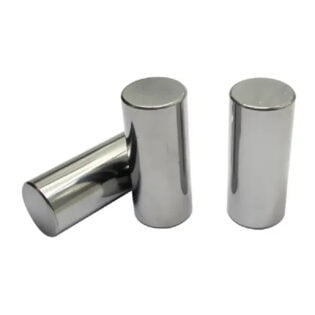Hastelloy B-3 (Nickel B-3) Bande, Feuille, Fil, ASTM B333
APPLICATIONS
Composants d'avions, de fours et de procédés chimiques, nids d'abeilles et composants de sections de combustion de turbines à gaz
DESCRIPTION
L'Hastelloy® B-3 est un alliage nickel-molybdène avec une excellente résistance aux piqûres, à la corrosion et à la fissuration par corrosion sous contrainte, ainsi qu'une stabilité thermique supérieure à celle de l'alliage B-2. Cet alliage a également une grande résistance à l'attaque de la ligne de couteau et de la zone affectée par la chaleur. La stabilité thermique améliorée de l'alliage B-3 minimise les problèmes associés à la fabrication de composants en alliage B-2. Cela est dû à la tendance réduite à précipiter des phases intermétalliques délétères dans l'alliage B-3, lui conférant ainsi une plus grande ductilité que l'alliage B-2 pendant et après diverses conditions de cyclage thermique.
Superalliage à base de nickel Hastelloy B-3
Hastelloy B-3 is a nickel-molybdenum alloy with excellent resistance to pitting, corrosion, and stress-corrosion cracking plus, thermal stability superior to that of alloy B-2. Hastelloy B-3 alloy is a new member of the nickel-molybdenum alloy family. It has excellent corrosion resistance to hydrochloric acid at any temperature and concentration. At the same time, it also has good corrosion resistance to sulfuric acid, acetic acid, formic acid, phosphoric acid and other non-oxidizing media. Moreover, due to the adjustment of its chemical composition, its thermal stability has been greatly improved compared to the original Hastelloy B-2 alloy. B-3 alloy has high resistance to pitting corrosion, stress corrosion cracking, knife corrosion and corrosion in the heat-affected zone of welding.
Compared with Hastelloy B-2 alloy, the biggest advantage of B-3 alloy is that it can still maintain excellent toughness when exposed to medium temperature for an instant. This exposure usually occurs regularly during the heat treatment of processing. When exposed to a temperature of 700°C for a short time, the B-2 alloy is very easy to embrittlement, while the B-3 alloy exhibits significant resistance to embrittlement and can make this exposure up to several hours. This provides great convenience for the alloy to be made into complex parts such as forming devices. Hastelloy B-3 alloy can be used for all purposes of previous B-2 alloy. Like B-2 alloy, Hastelloy B-3 is not recommended for use in environments where trivalent iron and divalent copper salts exist, because these salts will quickly cause corrosion damage. When hydrochloric acid comes into contact with iron and Fabrication d'acier lourd sur mesure pour l'approvisionnement en acier, it chemically reacts with iron and copper salts.
Hastelloy B-3 Chemical Composition:
| Ni | Mo | Fe | C | Co | Cr | Mn | Et | Tu | W | Al | Avec |
|---|---|---|---|---|---|---|---|---|---|---|---|
| 65.0 min | 28,5 | 1.5 | 00,01 maximum | 3,0 maximum | 1.5 | 3,0 maximum | 0.10 maximum | 0.2 maximum | 3,0 maximum | 0.50 maximum | 0.20 maximum |
Hastelloy B-3 Mechanical Properties:
- Tensile strength(Rm N/mm2): ≥ 760
- Yield strength(RP0.2N/mm2 ): ≥ 350
- Elongation(A5%): 40
Advantage:
- Control the minimum content of iron and chromium to prevent the formation of β-phase Ni4Mo
- Excellent corrosion resistance to reducing environment
- Excellent resistance to medium-concentration sulfuric acid and many non-oxidizing acids
- Very good resistance to chloride ion reduction stress corrosion cracking (SCC)
Hastelloy B-3 (N10675) welding and processing:
1. Material analysis:
Les propriétés mécaniques de Hastelloy B3 (N10675) Hastelloy sheet in solid solution state: as the heating temperature rises, its tensile strength, yield strength, and elastic modulus will decrease, while the elongation, thermal expansion coefficient, thermal conductivity and The specific heat increases slightly; and with the increase of the cold deformation rate, the hardness, tensile strength and yield strength increase, and the elongation decreases.
2. Forming characteristics: After analysis, the forming characteristics of Hastelloy B3 mainly include:
- Hastelloy B3 material has a high elongation rate, which creates favorable conditions for cold forming.
- Hastelloy B3 material is harder than austenitic stainless steel, and has a more obvious tendency to work hardening, so it needs more pressure during cold forming or step-by-step forming.
- When the cold forming deformation rate of Hastelloy B3 material is less than 10%, it will not affect the corrosion resistance of the processed parts, but in the welding process, the existence of residual stress may cause hot cracks in the weld. Therefore, for the workpieces that need to be welded in the later stage, the effect of residual stress should be eliminated as much as possible.
- Severely deformed cold forming will increase the yield ratio of Hastelloy B3 material, and increase the sensitivity of stress corrosion and cracking. Intermediate and final heat treatment processes are often used.
- Hastelloy B3 material is very sensitive to oxidizing media and sulfur, phosphorus, lead and other low melting point metals at high temperatures.













